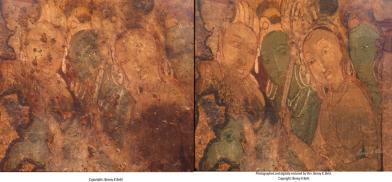Earliest-surviving Hindu painting - digitally restored and unveiled to the world
A historical milestone was achieved when the digitally restored image of the earliest surviving Hindu painting from the 6th century was unveiled for the world to see

A historical milestone was achieved when the digitally restored image of the earliest surviving Hindu painting from the 6th century was unveiled for the world to see. This unique image, from Badami caves in Karnataka state in southern India will be preserved for posterity in the Arctic World Archives (AWA) at Svalbard near the North Pole, in Norway.
The painting, titled Queen and Attendants, is one of the many in the Badami caves which were photographed by renowned art historian, photographer and filmmaker, Benoy K Behl known for his work in documenting the art heritage of India and Asia. He has carefully restored the image digitally, thereby preserving it for posterity. This and the other paintings in the Badami caves, said Behl, embodies “the hallmark of Indian art” with its sublime, inward-looking expressions and compassion that transcends the physical barrier.
The Badami cave temples represent some of the earliest known examples of Hindu temples in the Deccan region. They along with the temples in Aihole transformed the Malaprabha River valley into a cradle of temple architecture that influenced the components of later Hindu temples elsewhere in India, according to archaeologists and arti historians.

Behl has done similar restoration and digitisation work for the 5th century Ajanta Caves in Maharashtra.
“The quality of art seen in these paintings (Badami caves, Ajanta caves) can be seen in the West much later, during the period of the impressionists,” Behl said, underlining the technical, intellectual and cultural advancement of our ancestors. This event, therefore, is of global significance because it showcases India’s rich heritage and its contribution to the world of art.
The Badami cave image was released in a virtual event that was attended by Vinay Sahasrabuddhe, president of the Indian Council for Cultural Relations (ICCR), Suresh Prabhu, MP, Amish Tripathi, renowned author Director, Nehru Centre, London. Art connoisseurs and diplomats from across the world were a part of the virtual audience.
Recalling the great art historian Ananda K. Coomaraswamy’s writings, Sahasrabuddhe said that the significance of Behl’s work lay in the fact that it "strives to tell us about our own history and make future generations aware of the rich legacy they carry forward"
He also talked about a future course of action in four crisp points: that artisans must be brought in the fold of art and culture; the importance of cultural relations and soft power in diplomatic ties; using India's art restoration technology to help other countries; and encouraging more development in art restoration technology.
In his trademark style, Amish Tripathi encapsulated the importance of this event with the African saying, loosely translated as 'Until the lion learns to write, every story will glorify the hunter'.
“We need to tell our own stories,” Tripathi said.
Sapio Analytics. a Mumbai-based company that focuse\s on creating high-end data-based algorithms powered by AI, along with Ajanta HC, London will showcase these path-breaking photographs and their digital restoration by Benoy Behl in exhibitions around the world in 2022 to mark India’s 75th year of independence.
(The writer is an award-winning independent journalist. She can be contacted at azera.rahman@gmail.com)










Post a Comment